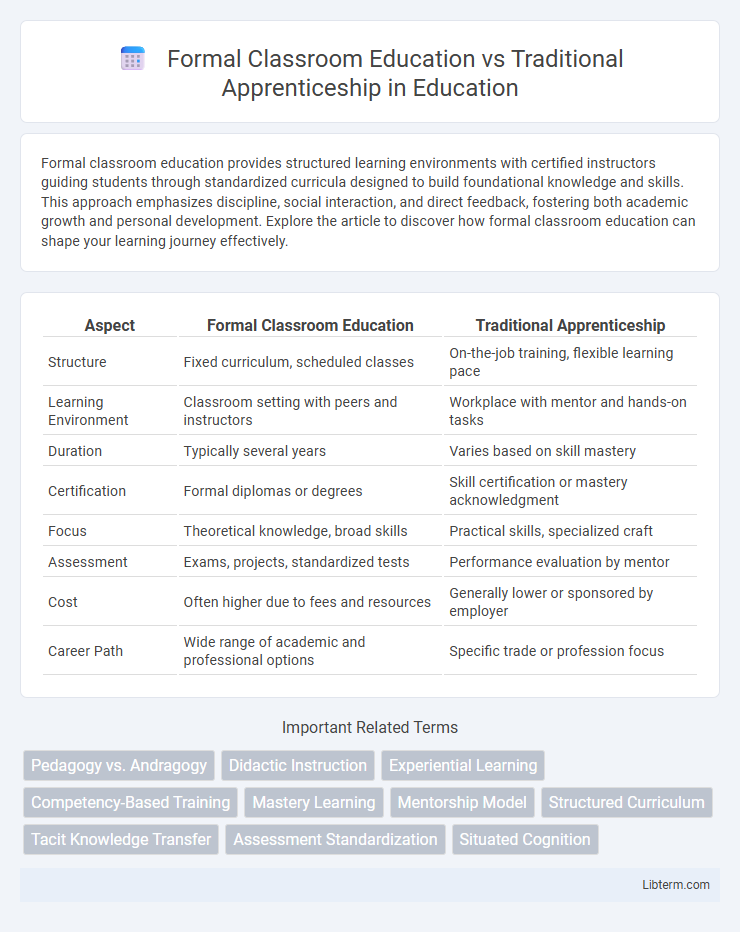Formal classroom education provides structured learning environments with certified instructors guiding students through standardized curricula designed to build foundational knowledge and skills. This approach emphasizes discipline, social interaction, and direct feedback, fostering both academic growth and personal development. Explore the article to discover how formal classroom education can shape your learning journey effectively.
Table of Comparison
| Aspect | Formal Classroom Education | Traditional Apprenticeship |
|---|---|---|
| Structure | Fixed curriculum, scheduled classes | On-the-job training, flexible learning pace |
| Learning Environment | Classroom setting with peers and instructors | Workplace with mentor and hands-on tasks |
| Duration | Typically several years | Varies based on skill mastery |
| Certification | Formal diplomas or degrees | Skill certification or mastery acknowledgment |
| Focus | Theoretical knowledge, broad skills | Practical skills, specialized craft |
| Assessment | Exams, projects, standardized tests | Performance evaluation by mentor |
| Cost | Often higher due to fees and resources | Generally lower or sponsored by employer |
| Career Path | Wide range of academic and professional options | Specific trade or profession focus |
Introduction: Defining Formal Classroom Education and Traditional Apprenticeship
Formal classroom education involves structured learning within schools or universities, emphasizing standardized curricula, theoretical knowledge, and assessment-based progress. Traditional apprenticeship focuses on hands-on training under the guidance of skilled professionals, fostering practical skills and real-world experience in a specific trade or craft. Both methods aim to develop expertise, but they differ in delivery, scope, and learning environment.
Historical Overview of Learning Systems
Formal classroom education emerged during the Industrial Revolution, emphasizing standardized curricula, structured schedules, and theoretical knowledge delivery within institutional settings. Traditional apprenticeship, dating back to medieval guild systems, relied on hands-on, experiential learning where novices acquired skills through direct mentorship under skilled artisans. The historical shift from apprenticeships to formal education reflects broader societal changes toward mass literacy and industrial workforce needs, prioritizing generalized knowledge over specialized craft mastery.
Structure and Curriculum: Classroom vs Apprenticeship
Formal classroom education features a structured curriculum designed by educational institutions with standardized subjects, assessments, and learning objectives. Traditional apprenticeship offers a flexible, hands-on learning experience tailored to specific trades or crafts, emphasizing real-world skills over theoretical knowledge. Classroom education prioritizes comprehensive theory and broad knowledge, while apprenticeships focus on practical skill development through direct mentorship.
Role of Instructors and Mentors
In formal classroom education, instructors lead structured lessons with standardized curricula, ensuring consistent delivery of theoretical knowledge across diverse student groups. Traditional apprenticeships rely heavily on mentors who offer personalized, hands-on guidance, adapting teaching to the apprentice's pace and practical skill development. The mentor's role in apprenticeships fosters direct industry experience and nuanced craftsmanship, contrasting with the more generalized oversight by classroom instructors.
Skill Acquisition: Theory Versus Practice
Formal classroom education emphasizes theoretical knowledge acquisition through structured curricula, textbooks, and lectures, providing foundational understanding across diverse subjects. Traditional apprenticeship prioritizes hands-on skill development through direct practice, mentorship, and real-world experience, facilitating immediate application of techniques in professional settings. Combining both approaches enhances comprehensive skill acquisition by integrating conceptual frameworks with practical expertise.
Flexibility and Customization in Learning Paths
Formal classroom education offers structured curricula with limited flexibility, adhering to standardized learning schedules and assessment methods. Traditional apprenticeships provide highly customizable learning paths tailored to individual skill development and real-time feedback within specific trades or crafts. Flexibility in apprenticeships allows learners to progress at their own pace, adapting to personal strengths and industry demands, unlike the rigid timelines typical in formal education settings.
Assessment and Evaluation Methods
Formal classroom education employs standardized assessments such as exams, quizzes, and written assignments to measure student progress and comprehension systematically. Traditional apprenticeship relies on hands-on evaluation, where mentors assess skill proficiency through direct observation and practical performance in real-world tasks. Both methods emphasize continuous feedback, but formal education prioritizes theoretical understanding, while apprenticeships focus on applied mastery in occupational contexts.
Career Outcomes and Employability
Formal classroom education provides structured curricula and recognized certifications that enhance employability by equipping students with theoretical knowledge and transferable skills applicable across industries. Traditional apprenticeship offers hands-on experience, industry-specific skills, and direct mentorship, often resulting in faster entry into specialized trades with immediate job readiness. Career outcomes improve when combining formal education with apprenticeship, as this blend ensures both comprehensive understanding and practical expertise sought by employers.
Socialization and Networking Opportunities
Formal classroom education offers structured socialization environments through group projects, peer interactions, and organized extracurricular activities that foster broad networking opportunities with diverse student populations and faculty. Traditional apprenticeships provide immersive one-on-one mentorship and hands-on experience within professional settings, enabling close relationships with industry experts and direct entry into specialized networks. Both methods cultivate essential professional connections, but formal education emphasizes broader social exposure while apprenticeships focus on deep, practical ties within specific trades.
Conclusion: Choosing the Best Path for Individual Goals
Selecting between formal classroom education and traditional apprenticeship depends on individual career goals, learning preferences, and industry requirements. Formal education offers structured curricula and recognized credentials beneficial for professions demanding theoretical knowledge and certification, while apprenticeships provide hands-on experience and practical skills essential in trades and crafts. Aligning the choice with personal aspirations and market demands ensures optimal career development and skill acquisition.
Formal Classroom Education Infographic

 libterm.com
libterm.com